《ICRU号报告》PPT课件
- 格式:ppt
- 大小:15.48 MB
- 文档页数:98

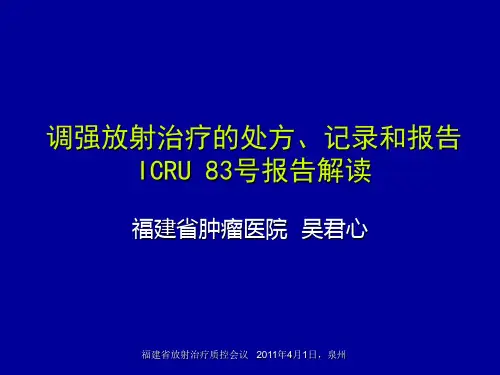
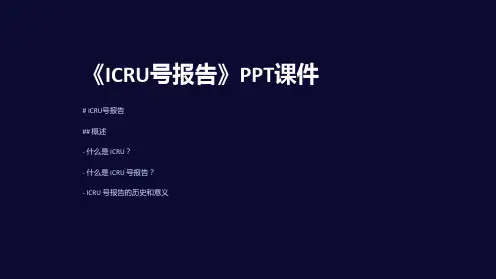
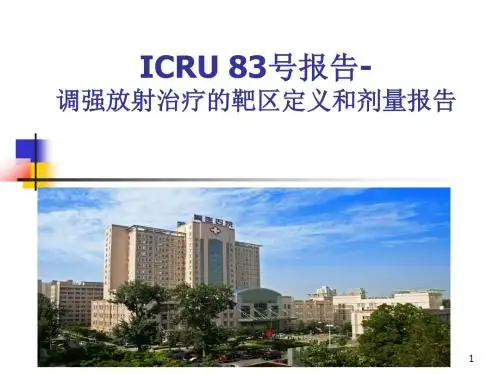
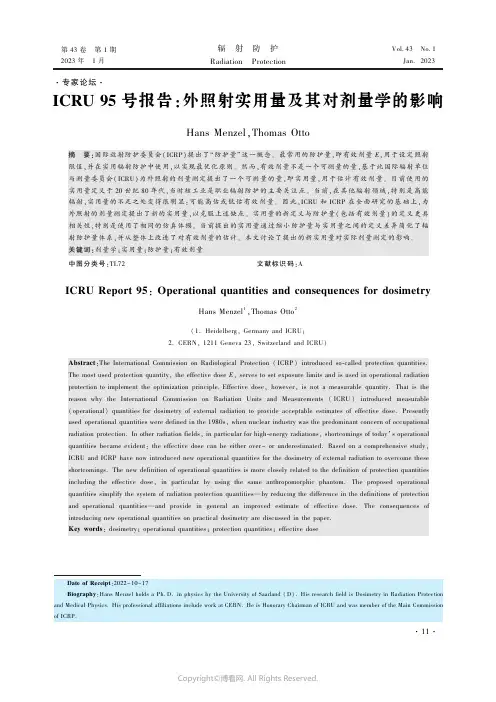
㊀第43卷㊀第1期2023年㊀1月㊀辐㊀射㊀防㊀护Radiation㊀ProtectionVol.43㊀No.1㊀㊀Jan.2023㊃专家论坛㊃ICRU95号报告:外照射实用量及其对剂量学的影响Hans Menzel,Thomas Otto㊀摘㊀要:国际放射防护委员会(ICRP)提出了 防护量 这一概念㊂最常用的防护量,即有效剂量E,用于设定照射限值,并在实用辐射防护中使用,以实现最优化原则㊂然而,有效剂量不是一个可测量的量,基于此国际辐射单位与测量委员会(ICRU)为外照射的剂量测定提出了一个可测量的量,即实用量,用于估计有效剂量㊂目前使用的实用量定义于20世纪80年代,当时核工业是职业辐射防护的主要关注点㊂当前,在其他辐射领域,特别是高能辐射,实用量的不足之处变得很明显:可能高估或低估有效剂量㊂因此,ICRU和ICRP在全面研究的基础上,为外照射的剂量测定提出了新的实用量,以克服上述缺点㊂实用量的新定义与防护量(包括有效剂量)的定义更具相关性,特别是使用了相同的仿真体模㊂当前提出的实用量通过缩小防护量与实用量之间的定义差异简化了辐射防护量体系,并从整体上改进了对有效剂量的估计㊂本文讨论了提出的新实用量对实际剂量测定的影响㊂关键词:剂量学;实用量;防护量;有效剂量中图分类号:TL72文献标识码:AICRU Report95:Operational quantities and consequences for dosimetryHans Menzel1,Thomas Otto2(1.Heidelberg,Germany and ICRU;2.CERN,1211Geneva23,Switzerland and ICRU)Abstract:The International Commission on Radiological Protection(ICRP)introduced so-called protection quantities. The most used protection quantity,the effective dose E,serves to set exposure limits and is used in operational radiation protection to implement the optimization principle.Effective dose,however,is not a measurable quantity.That is the reason why the International Commission on Radiation Units and Measurements(ICRU)introduced measurable (operational)quantities for dosimetry of external radiation to provide acceptable estimates of effective dose.Presently used operational quantities were defined in the1980s,when nuclear industry was the predominant concern of occupational radiation protection.In other radiation fields,in particular for high-energy radiations,shortcomings of today s operational quantities became evident:the effective dose can be either over-or underestimated.Based on a comprehensive study, ICRU and ICRP have now introduced new operational quantities for the dosimetry of external radiation to overcome these shortcomings.The new definition of operational quantities is more closely related to the definition of protection quantities including the effective dose,in particular by using the same anthropomorphic phantom.The proposed operational quantities simplify the system of radiation protection quantities by reducing the difference in the definitions of protection and operational quantities and provide in general an improved estimate of effective dose.The consequences of introducing new operational quantities on practical dosimetry are discussed in the paper.Key words:dosimetry;operational quantities;protection quantities;effective dose㊀㊀Date of Receipt:2022-10-17Biography:Hans Menzel holds a Ph.D.in physics by the University of Saarland(D).His research field is Dosimetry in Radiation Protection and Medical Physics.His professional affiliations include work at CERN.He is Honorary Chairman of ICRU and was member of the Main Commission of ICRP.㊃11㊃㊀辐射防护第43卷㊀第1期㊀㊀Radiation protection is based on limiting and optimizing radiation exposure of workers and the general public.To meet this objective,radiation protection needs a yardstick ,a quantity that relates to radiation risk.In1990,the International Commission on Radiological Protection(ICRP) introduced so-called protection quantities.The most used protection quantity,the effective dose E,serves to limit and to minimize stochastic radiation effects after whole-body irradiation.The quantity most used in operational and in general radiation protection is the effective dose,E.The definition of E is based on mean absorbed doses in specified tissues and organs, T,in the ICRP-ICRU reference phantom.These organ doses are each weighted with a radiation weighting factor w R(for external radiation the incoming radiation)which is intended to account for differences in radiation quality of different types of radiation(in case of neutron different energies). The radiation weighted organ doses,often called organ equivalent dose,are then weighted by organ/ tissue specific tissue weighting factors,w T.The values of w T are related to the relative detriment of the different organs and were derived from epidemiological data.All w T values are less than1 and the sum over all w T values is1[1-2]:E=ðT w TðR w R D R,T.㊀㊀In words:E is the(tissue)weighted average of organ equivalent doses.Effective dose is universally applicable to all types of radiation and to external as well as to internal radiation.The concept of effective dose is well established in practice for almost4decades.Legal exposure limits,constraints and guidelines are set in units of effective dose,and in operational radiation protection E is the objective of the optimisation process.Radiation exposure quantified in terms of E has to be reduced as much as reasonably achievable, after the ALARA principle.For external radiation,values of the effective dose are calculated for simple directions of incidence of the radiation field using numerical anthropomorphic phantoms[3-4].The results are so-called conversion coefficients,which are the values of the effective dose per unit of particle fluence or, alternatively for photons,(comma)per air kerma. 1㊀Current operational quantities㊀㊀Effective dose is in practice not measurable. This is the reason why the International Commission on Radiation Units and Measurements(ICRU) defined measurable(or operational)quantities for the calibration of dosimeters and radiation measurement instruments.Operational quantities are defined in a point and are intended to provide the best possible approximation of the protection values. The current operational quantities personal dose equivalent H p(10,α)and the ambient dose equivalent H∗(10)[5-6]are used to provide approximate values for effective dose E.Personal dose equivalent is used to calibrate personal dosimeters,i.e.,for the retrospective assessment of effective dose of a potentially radiation exposed person.This is used to demonstrate that exposure limits and other regulatory values have been respected in operational radiation protection.Real-time personal dosimeters are used during ongoing activities to monitor exposure on-line.Personal dose equivalent is defined as the absorbed dose at a depth of10mm at a representative position of the body,multiplied with the quality factor Q(L),defined as function of the unrestricted linear energy transfer L.A rectangular phantom made from ICRU four-component tissue is used for the calculation of conversion coefficients of the personal dose equivalent[7-8],and a water-filled,rectangular ISO phantom is used to calibrate personal dosimeters.Radiation protection monitors are calibrated in ambient dose equivalent H∗(10)for prospective radiation protection measurements and for environmental measurements. Ambient dose equivalent is defined in terms of absorbed dose at10mm depth in the fictitious ICRU sphere and the quality factor Q(L),in the extended㊃21㊃HANS Menzel et al.ICRU Report 95:Operational quantities and consequences for dosimetry㊀and aligned radiation fields,a concept that assumesan isotropic homogeneous response of the monitor.The present operational quantities were defined in the1980s,when the nuclear industry was the most important field of radiation protection.In the typicalradiation fields of this industry,these quantities provided very good estimates for the effective dose forexposure to photons and sufficiently good estimates for neutrons.With new applications of ionizingradiation,the shortcomings of today s operationalquantities became evident:at high radiation fieldenergies,occurring for example at accelerators,effective dose can be either over -or underestimated.Effective dose is overestimated in radiation fields with very low photon energies,occurring in interventional radiology or mammography.Figure 1shows theenergy dependence of effective dose and personaldose equivalent for photons,Figure 2is a similarrepresentation of effective dose and ambient doseequivalent forneutrons.The size was calculated using the kerma approximation,in which the secondary electrons release their energy at thepoint of origin (upper,light red curve)or with transport ofthe secondary electrons (lower,dark red curve).Theoverestimation and underestimation of the effective doseat very low and very high energies are clearly visibleFig.1㊀Energy dependence of the conversion coefficientsfrom photon fluence to effective dose in AP or ISOirradiation direction and to the personaldose equivalent H p (10.0o)The overestimation and underestimation of the effectivedose by the operational quantities are clearly visibleFig.2㊀Energy dependence of the conversion coefficientsfrom neutron fluence to effective dose in six different irradiation directions and to the parameters ambientdose equivalent H ∗(10)and depthequivalent dose H p (10.0o )2㊀Operational quantities in ICRU Report95㊀㊀The ICRU set up a working group to test andevaluate alternatives to a revision of H p (10)and H ∗(10)and finally agreed on the quantities personal dose H p (α)and ambient dose H ∗.Instead of basing the definition on the absorbed dose in a phantom,thenew parameters are defined directly as the product of a physical field quantity such as particle fluence,or air kerma for photons,and a conversion coefficient.The definition can symbolically be expressed as:H ∗(E )=h ∗(E )㊃Φ(E )H p (E ,α)=h p (E ,α)㊃Φ(E )㊀㊀The conversion coefficients H p and H ∗arecalculated using the same phantoms and the sameweighting coefficients w R and w T as for the calculationof effective dose E.Thenewdefinitionsandtheassociatedconversion coefficients were published at the end of2020,jointly with the ICRP,in ICRU Report 95[9].Personal dose H p (α)is defined for specific angles of incidence,while the definition of ambient dose H∗㊃31㊃㊀辐射防护第43卷㊀第1期contains a maximization of the quantity value over the direction of incidence.Based on their definitionalone,these two quantities provide a better estimateof the protection quantities;for some combinations of energy and angle of incidence,the numerical values of the operational and protection quantities are evenidentical.Figure 3shows the energy dependence of thepersonal dose for photons with an angle of 0o for theincoming radiation.Due to the definition of H P (0o),the curve fits exactly to the plot of E (AP),effectivedoseinanterior-posteriororientation.Similarrepresentations can be drawn for neutrons and othertypes ofradiation.The numerical agreement of personal dose with E (AP)isobvious,the two curves are congruentFig.3㊀Energy dependence of the conversion coefficientsfrom photon fluence to effective dose in AP or ISOirradiation direction and to personal dose H p (0o)The ICRU report [9]includes dose conversioncoefficients from particle fluence to the new quantitiesfor numerous particles (and in addition from airkerma for photons),extending to very high energies,as are present at particle accelerators and in cosmicrays.In addition,ICRU Report 95introduces newoperational quantities for the dose to the eye lens and to the local skin.These are now defined in terms of absorbed doses.Absorbed dose to the local skinD local skin differs only slightly from the current quantity H p (0.07).For photons,the values of absorbed doseto the eye lens D eye lens are sufficiently similar to the currently used quantity H p (3)so that the continueduse of existing eye-lens dosimeters is acceptable.3㊀Operational dosimetry in realistic radiationfields㊀㊀When new quantities are introduced,one has toinvestigate how the values measured with newlydefined operational quantities compare to thosemeasured using current operational quantities,inparticular to identify radiation fields for which there may be substantial differences.Here,we limitourselves to photon radiation fields,in which themajority of occupational exposure happens.Figure 4shows a relationship similar to Figures1and3,thistimeexpressedasconversioncoefficients from kerma in air.For the characteristicenergy range of photons emitted by radionuclides,100keV -3MeV,the measured quantity personal dose results in somewhat lower values than thepersonal dose equivalent.At very lowphotonenergies,asencounteredforexampleininterventional radiology or in mammography,theresults for the personal dose are significantly lower.This is because at these low energies personal doseequivalent H p (10)overestimates effective dose E bya factor of up to 5,This large overestimation is avoided by personal dose [10-11].Further investigations into the impact of the newoperational quantities on the numerical value ofmeasured doses in known radiation fields have beenand are currently carried out or are planned.They include radiation fields in medical practice,in the nuclear industry and at particle accelerators.4㊀Response of dosimeters and monitors tothe new quantities㊀㊀The principal use of operational quantities is thecalibration of personal dosimeters and radiationprotection monitors.The suitability of existing andcurrently used radiation instruments calibrated in the new quantities and their continued use for radiation㊃41㊃HANS Menzel et al.ICRU Report95:Operational quantities and consequences for dosimetry㊀In the energy range of radionuclides,the new quantitydelivers only slightly lower results.At low photonenergies,the differences are more pronounced Fig.4㊀Energy dependence of personal dose equivalentHp(10)(red)and of personal dose H p(green)forphotons as a function of kerma in air protection measurements depends on the type of the dosimeter or instrument,and the area of application[12-13].Figure5shows the relative response for a common Geiger-Müller counter-based instrument for photon radiation.The shielding effect of the solid housing ensures that the device is blind to photons with an energy below50keV.Such and similar dose rate monitors can continue to be used after recalibration to the new operational quantity ambient dose.Figure6shows the relative photon response of a modern personal dosimeter.According to the requirements,it correctly determines the personal dose equivalent H p(10)for photon energies down to 15or20keV.In doing so,however,it overestimates the effective dose of the photons and the new quantity personal dose.This effect was also found in an intercomparison campaign of dosimetry services[14].A simple recalibration is not possible,and innovative dosimeter developments are required to correctly record radiation exposure in terms of the new dosimetric quantity[15-16].Rem-counters,widely used as area monitors for neutrons,deliver dose values within broadThe robust housing cuts off low-energy photon radiation and a simple recalibration at the reference energy of 662keV(arrow)would correct the overestimation of theambient dose H∗by approx.15%Fig.5㊀Relative response of a common Geiger-Müller canter-based survey instrument for photonradiationA simple recalibration would not suffice to correct theresponse of the dosimeter to personal doseH p over the full energy rangeFig.6㊀Relative response of a modern personal dosimeter acceptance limits defined by the IEC.The change to operational quantities recommended in ICRU Report 95will at the most require a recalibration and a slight adjustment of the acceptance limits[17].The new quantities can and will not be introduced as legally and regulatory valid before the next general recommendations of the ICRP have been published,which is not likely to happen before 2030.That implies a generous duration for the㊃51㊃㊀辐射防护第43卷㊀第1期adjustment phase in which the current quantities remain valid.This timetable will leave ample time to assess the consequences in all relevant radiation fields and,where necessary,to develop suitable radiation monitors and personal dosimeters.5㊀Conclusion㊀㊀ICRU and ICRP have introduced new operational quantities for the dosimetry of external radiation. Their definition is based on the protection quantities, notably the effective dose,i.e.a whole-body radiation quantity.The proposed operational quantities simplify the system of radiation protection quantities by removing the difference of the current concepts the definitions of protection and operational quantities.Changes in the measured values are to be expected at low photon energies,where the overestimation of the effective dose by current operational quantities is avoided.In this energy range,an adjustment of personal dosimeters will become necessary.The consequences of introducing the new operational quantities in other radiation fields and on different dosimeter types are currently examined by various institutions.It is estimated that it will take15-20years before the new quantities become legally mandatory,which is sufficient time for research and development and related adjustments for instrumentation.References:[1]㊀International Commission on Radiological Protection.1990Recommendations of the International Commission onRadiological Protection.ICRP Publication60.Pergamon Press,Oxford,1991.[2]㊀International Commission on Radiological Protection.The2007Recommendations of the International Commission onRadiological Protection.ICRP Publication103.Elsevier Science,Oxford,2007.[3]㊀International Commission on Radiological Protection.Adult Reference Computational Phantoms.ICRP Publication110.Elsevier Science,Oxford,2009.[4]㊀International Commission on Radiological Protection.Conversion Coefficients for Radiological Protection for ExternalRadiation Exposures.ICRP Publication116.Elsevier Science,Oxford,2010.[5]㊀International Commission on Radiation Units and Measurements.Determination of Dose Equivalents Resulting from ExternalRadiation Sources.ICRU Report39.ICRU,Bethesda,1985.[6]㊀International Commission on Radiation Units and Measurements.Quantities and Units in Radiation Protection Dosimetry.ICRU Report51.ICRU,Bethesda,1993.[7]㊀International Commission on Radiation Units and Measurements.Conversion Coefficients for Use in Radiological Protectionagainst External Radiation.ICRU Report57.ICRU,Bethesda,1998.[8]㊀International Commission on Radiological Protection.Conversion Coefficients for Use in Radiological Protection againstExternal Radiation.ICRP Publication74.Elsevier Science,Oxford,1996.[9]㊀International Commission on Radiation Units and Measurements.Operational Quantities for External Radiation Exposure.ICRU Report95.SAGE Publ.,2020.[10]㊀Otto T.Conversion coefficients from kerma to ambient dose and personal dose for X-ray.spectra.J Inst,2019,14:11011-11011.[11]㊀Behrens R,Otto T.Conversion coefficients from total air kerma to the newly proposed ICRU/ICRP operational quantities forradiation protection for photon reference radiation qualities.J Radiol Prot,2022,42:011519.[12]㊀Otto T.Response of photon dosimeters and survey instruments to new operational quantities proposed by ICRU RC26.J Inst,2019,14:01010-01010.[13]㊀Ekendahl D,et al.Response of Current Photon Personal Dosemeters to New Operational Quantities.Radiation ProtectionDosimetry,2020,190:45-57.[14]㊀Caresana M,et al.Impact of new operational dosimetric quantities on individual monitoring services.J Radiol Prot,2021,41:1110-1121.[15]㊀Eakins J S,Tanner R J.The effects of revised operational dose quantities on the response characteristics of a beta/gammapersonal dosemeter.J Radiol Prot,2019,39:399-421.[16]㊀Hoedlmoser H,Bandalo V,Figel M.BeOSL dosemeters and new ICRU operational quantities:Response of existingdosemeters and modification options.Radiation Measurements,2020,139:106482.[17]㊀Eakins J S,Tanner R J,Hager L.The effects of a revised operational dose quantity on the response characteristics of neutronsurvey instruments.J Radiol Prot,2018,38:688.㊃61㊃。
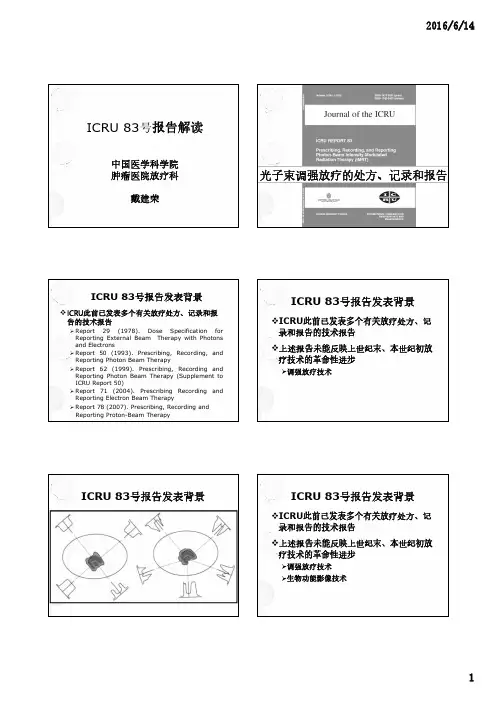

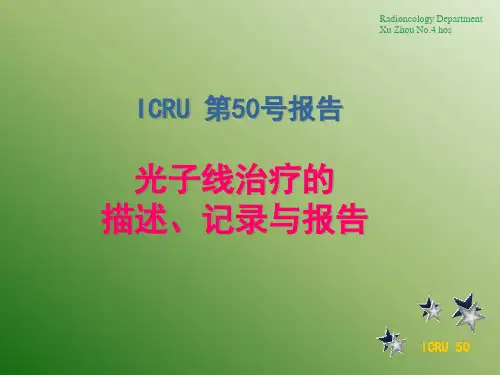
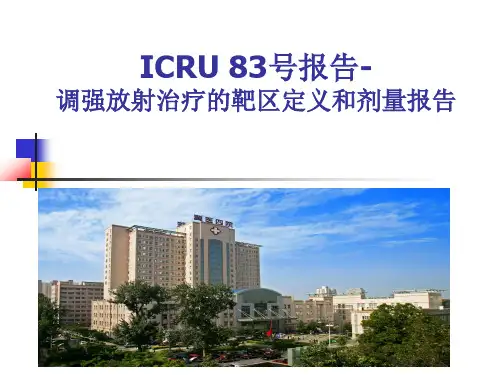
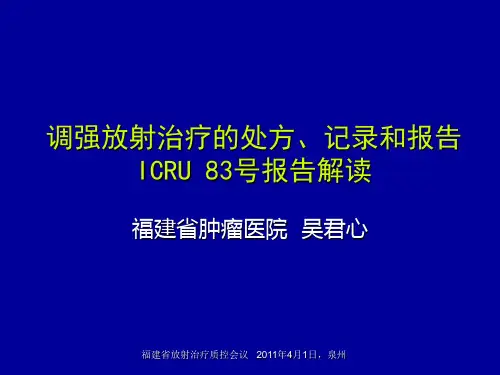
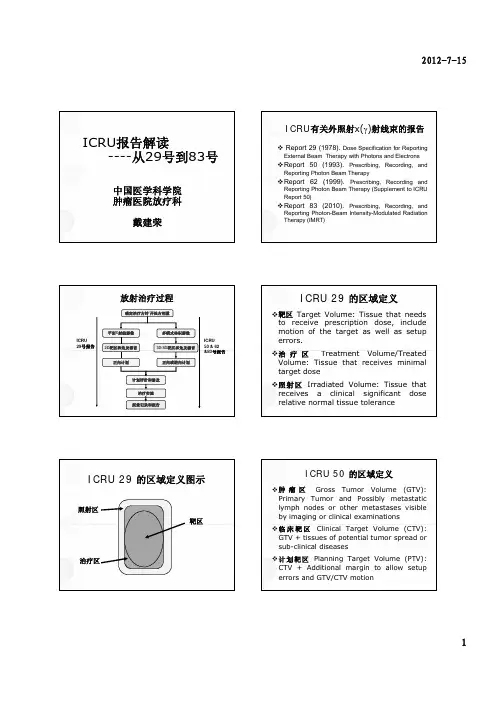
ICRU 62号报告执行概要1本报告与ICRU 50号报告的关系本报告是1993年公布的ICRU50号报告(“光子束治疗的处方、记录和报告”)的增补篇。
50号报告包含了关于“怎样报告光子束外照射治疗”的建议。
这些建议被用一种在全世界各放疗中心都能普遍执行的规范制式化了。
50号报告的公布和它的临床应用引起了人们的广泛兴趣,也提出一些问题,有时还引发一些激烈的讨论和争论。
50号报告发布后的几年来,随着很多放疗技术和程序的引入,照射技术获得了长足的发展。
这促使三维图象的质量要有显著的改进,因为它直接确定了靶体积、感性趣的体积以及重要敏感器官的体积。
当然,治疗计划系统也必须跟上这一发展。
2本增补报告的目的由于上述原因,为了更准确地规范某些定义、概念、并考虑技术和临床的发展,ICRU决定发布一个增补文件。
当实施放射治疗时,为了处方、记录和报告等多种目的,必须确定治疗体积和剂量。
但推荐治疗技术和吸收剂量不是ICRU的目标和任务。
而很明显,能确保共同理解的不含糊的定义、能被广泛接受的概念和术语是至关重要的。
3体积和边界适形放疗的发展、对治疗增益的期望及漏照某些癌细胞的危险的增加,要求更准确的定义围绕靶体积的边界。
GTV(Gross Tumor Volume)和CTV(Clinical Target Volume)的概念不需再考虑,因为那是不依赖于任何技术发展的肿瘤学的概念。
但是,当要勾画计划靶体积(PTV)和确定相应的边界时,却应该考虑很多因素并应作出准确的标志。
在本报告中,内扩边(Internal Margin,IM )定义为考虑了相对于解剖参考点的CTV的大小、形状、位置的变化(例如:胃或膀胱的充盈程度,由呼吸引起的运动等等);摆位扩边(Set up Margin ,SM )是指进一步又考虑了由摆位等引起的病人与射线位置之间的所有不确定度后CTV的边界。
区分IM和SM是为了反映不确定度的不同来源:IM主要是由生理过程引起的,它是难于或者不能完全控制的;相反,因为SM主要是由技术因素引起的,故可通过更精确地摆位、固定患者、改进机器设备的机械稳定性等措施减小之。
ICRU 62号报告发表者:冯正富(访问人次:1198)ICRU 62号报告(1999年颁布)(301 医院王所亭详细摘译)执行概要1 本报告与I CRU 50号报告的关系本报告是1993年公布的ICRU50号报告(“光子束治疗的处方、记录和报告”)的增补篇。
50号报告包含了关于“怎样报告光子束外照射治疗”的建议。
这些建议被用一种在全世界各放疗中心都能普遍执行的规范制式化了。
50号报告的公布和它的临床应用引起了人们的广泛兴趣,也提出一些问题,有时还引发一些激烈的讨论和争论。
50号报告发布后的几年来,随着很多放疗技术和程序的引入,照射技术获得了长足的发展。
这促使三维图象的质量要有显著的改进,因为它直接确定了靶体积、感性趣的体积以及重要敏感器官的体积。
当然,治疗计划系统也必须跟上这一发展。
2 本增补报告的目的由于上述原因,为了更准确地规范某些定义、概念、并考虑技术和临床的发展,ICRU决定发布一个增补文件。
当实施放射治疗时,为了处方、记录和报告等多种目的,必须确定治疗体积和剂量。
但推荐治疗技术和吸收剂量不是ICRU的目标和任务。
而很明显,能确保共同理解的不含糊的定义、能被广泛接受的概念和术语是至关重要的。
3 体积和边界适形放疗的发展、对治疗增益的期望及漏照某些癌细胞的危险的增加,要求更准确的定义围绕靶体积的边界。
GTV(Gross Tumor Volume)和CTV(Clinical Target Volume)的概念不需再考虑,因为那是不依赖于任何技术发展的肿瘤学的概念。
但是,当要勾画计划靶体积(PTV)和确定相应的边界时,却应该考虑很多因素并应作出准确的标志。
在本报告中,内扩边(Internal Margin,IM )定义为考虑了相对于解剖参考点的CTV的大小、形状、位置的变化(例如:胃或膀胱的充盈程度,由呼吸引起的运动等等);摆位扩边(Set up Margin ,SM )是指进一步又考虑了由摆位等引起的病人与射线位置之间的所有不确定度后CTV的边界。